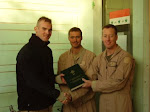Turning "Together Toward the Lord"
By Father Kevin M. Cusick
The futile closed circle of therapeutic naval-gazing hangs on like an overused joke in a few places still, one of them being the Church. The priest and people facing each other during the entire liturgy is a vestige of the illegitimate seizure and subjection of 2,000-year-old liturgical development by primitivist vandals in the post-Vatican period. The only thing this unscholarly lot left undone was to demand the liturgy be celebrated in Aramaic.
More and more young people are creating a buzz about ad orientem worship, in which the priest and people turn toward the Lord together during the Eucharistic prayer, in a renewed push to recover the sacred and cast off the tired and broken stereotypes of the 60’s. One of the places where this buzz is evident is among the numerous educated and loquacious young Catholics on the blogosphere, Facebook, Twitter and other social media.
The internet ferment ranges from popular images of priests offering the liturgy at the high altar to quotes from Chapter 3 of Pope Benedict (Cardinal Ratzinger) in The Spirit of the Liturgy:
“The turning of the priest towards the people has turned the community into a self-enclosed circle. In its outward form, it no longer opens out on what lies ahead and above, but is closed in on itself. The common turning towards the East was not a 'celebration towards the wall'; it did not mean that the priest 'had his back to the people': the priest himself was not regarded as so important. For just as the congregation in the synagogue looked together toward Jerusalem, so in the Christian liturgy the congregation looked together 'towards the Lord.'"
"As one of the Fathers of Vatican II’s Constitution on the Liturgy, J. A. Jungmann, put it, it was much more a question of priest and people facing in the same direction, knowing that together they were in a procession towards the Lord. They did not close themselves into a circle, they did not gaze at one another, but as the pilgrim People of God they set off for the Oriens, for the Christ who comes to meet us.”
Beside the fact that primitivism has been condemned by the Church’s Magisterium, there is this to say about a blind reaching only for what is most ancient without regard to other criteria:
“On the other hand, it is important and necessary to see that we cannot take as our norm the ancient in itself and as such, nor must we automatically write off later developments as alien to the original form of the liturgy. There can be a thoroughly living kind of development in which a seed at the origin of something ripens and bears fruit. We shall have to come back to this idea in a moment. But in our case, as we have said, what is at issue is not a romantic escape into antiquity, but a recovery of something essential, in which Christian liturgy expresses its permanent orientation.
"Of course, Häussling thinks that turning to the east, toward the rising sun, is something that nowadays we just cannot bring into the liturgy. Is that really the case? Are we today really hopelessly huddled in our own little circle? Is it not important, precisely today, to find room for the dimension of the future, for hope in the Lord who is to come again, to recognize again, indeed to live, the dynamism of the new creation as an essential form of the liturgy?”
A people without a future, a movement without “movement” does not promise life and closes off hope. This important aspect of the living liturgy which starts with Christ and ends with Him, the Alpha and the Omega, cannot serve its intended purpose as the nourishment of living Faith.
“But, Father,” some people say, “we like to see what you are doing during the Mass.” I wonder if these are the same folks who complain because they think that every Mass is the same.
Pope Benedict has this to say about the fact that there is One whom we should face together, including the priest:
“On the other hand, a common turning to the East during the Eucharistic Prayer remains essential. This is not a case of something accidental, but of what is essential. Looking at the priest has no importance. What matters is looking together at the Lord. It is not now a question of dialogue, but of common worship, of setting off towards the One who is to come. What corresponds with the reality of what is happening is not the closed circle, but the common movement forward expressed in a common direction for prayer.”
In our time of abundant information, of news good and bad about the Church and her members, is there any need more urgent than to emphasize that Jesus Christ alone is Lord and Savior of every human person, and that our priests need to prioritize prayer, their own as well as that of the people gathered for the liturgy?
Our faithful young people with their zest for life and instinct for its beauty will no doubt help to lead us in this journey “toward the Lord” for many years into the future.
(Follow Father Cusick on Facebook at Reverendo Padre-Kevin Michael Cusick and on Twitter @MCITLFrAphorism.)
A Prophet Who Prepares. A Homily for the Second Sunday of Advent
-
The Second Sunday of Advent usually features the Ministry of St. John the
Baptist. He was the Prophet who fulfilled the Office of Elijah of whom it
was s...
6 hours ago











No comments:
Post a Comment